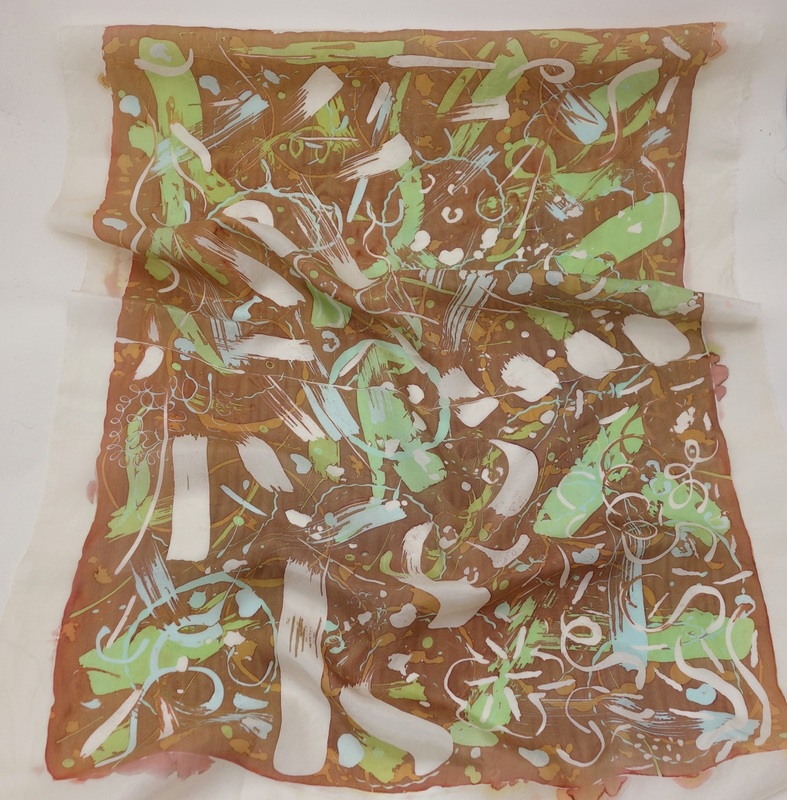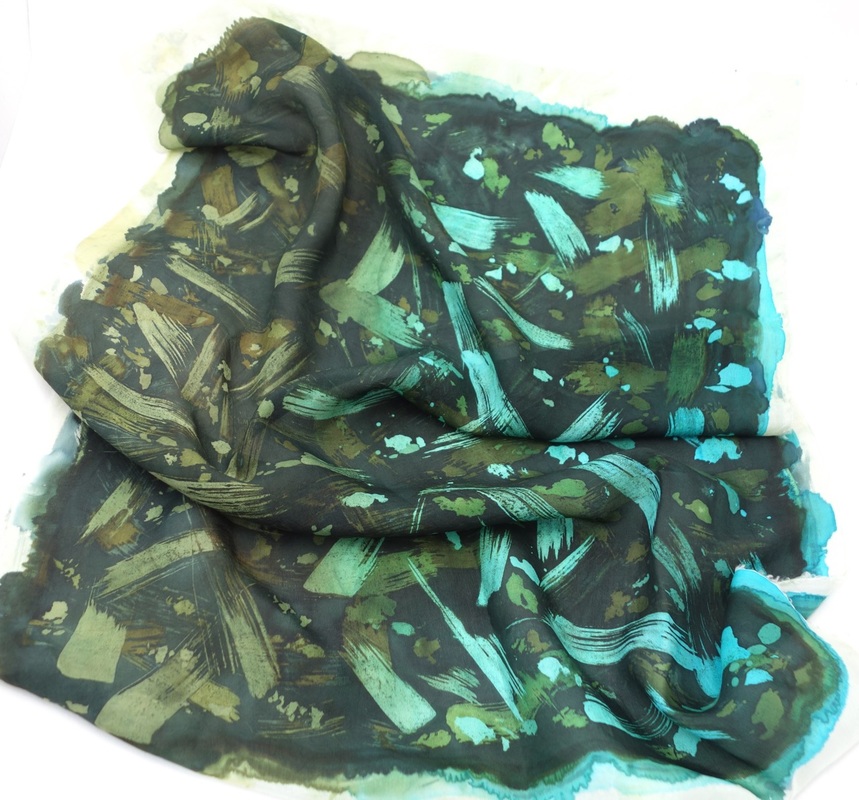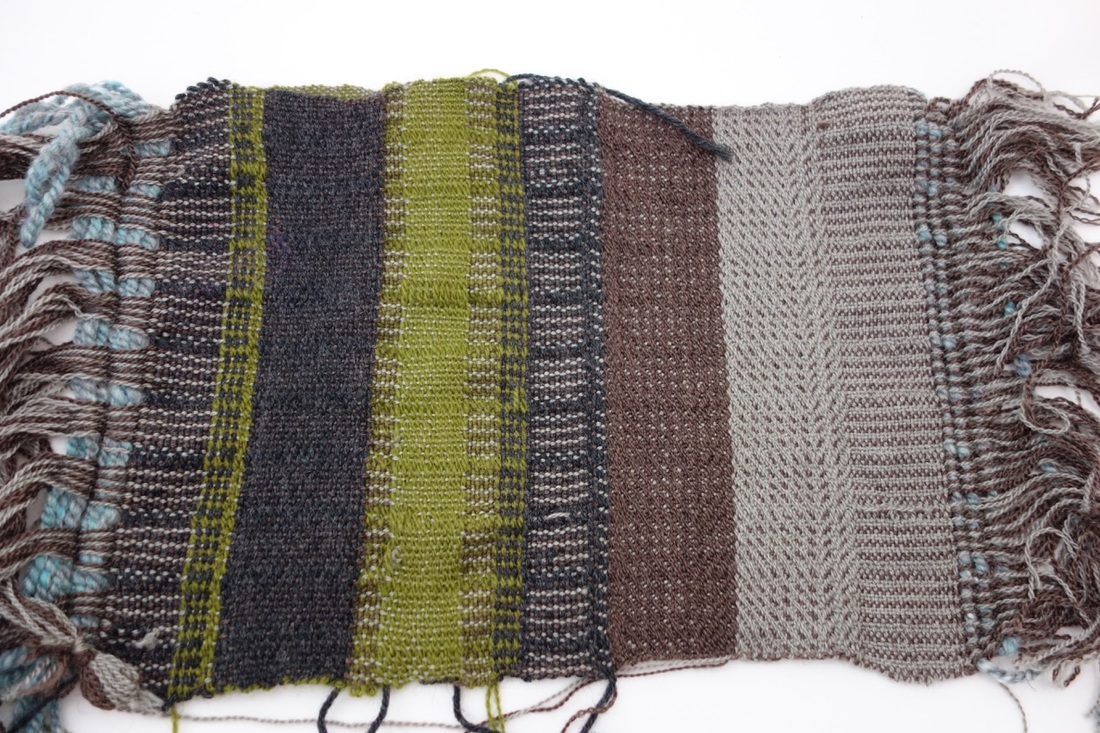|
While the last post was an overview of everything Summer School related, this one is a bit more about me and what I did during the week. I was lucky enough to spend the first part of the week on the Wax Resist on Silk Course with Isabella Whitworth. Theoretically this is well within my comfort zone, I spend all day applying colour to fibres, and do have a reasonable eye for line and pattern. The course was so much more than I had ever hoped for though. Just far enough outside my comfort zone to stretch me creatively, but close enough to my existing skills to make it relaxing. The biggest learning curve was undoubtably the wax element of the course. In essence it's a form of batik, which is definitely something I'd never done before. Our first test piece was all about learning how the wax behaves with the variety of different tools. Isabella has a fabulous collection of brushes, traditional cantings, and other found objects all of which can be dipped in to the wax pot and used to make a mark. It quickly became obvious that learning to draw recognisable shapes in 2 days was not going to be my forte, so instead I focused on the more abstract mark making and went with what I know, which is colour! In my second piece I focused on 2 brushes whose mark I liked from the test piece, and instead got to know how I could build up layers of colour. This piece is actually made up of a series of gradients washed on to the silk in layers. In this technique you alternate making wax marks with applying a wash of colour, then add more wax to preserve the colour of the previous layer, then add another wash of colour. Repeat until there's no more space! The error with this piece was to start off too dark with my first colour wash, it left me nowhere to go as there's only so much dye the silk can soak up. I then moved on to a scarf... I've only got this photo of it as it's now living with wriggefingers. Same principal, different shape this time, lots of overlapping wriggly circles made using a pastry cutter. This time I started off light, so there are a huge number of colours in this project progressing from pale yellow, to orange to deep red, then a final unifying layer of chocolate brown. For my final piece of work in the class I didn't want to do a scarf like everyone else. I am not a silk scarf wearer, and instead I fancied having something I could use as art. So 4 individual panels were stretched out... lacking in creative juices that afternoon I decided to go for a classic spring, summer, autumn, winter theme. Each panel started out with a very pale layer of colour, each one unique, but I made sure to share some of the colours with other panels so they all tied together. I carried on adding wax and colour until the silk was full. Then came the scary moment; covering up all that colour with a layer of dark browny/grey. I caused a few panic moments amongst my class mates, some of whom thought I should stop at the colourful stage, but I think I made the right decision! What I loved about this course was the speed at which your could develop an idea, with every piece you could see how it linked to the last one. It's not something I get to do very often in my other creative outlooks, they're all much more slow speed crafts, you don't get the same ability to test and change ideas. In the second half of the week I took part in a rigid heddle class with Dawn Willey. This class was far more technical, and was focused on setting up a rigid heddle loom to use 2 heddles. That means you can weave a cloth that is much finer, but also means you can some more complex weave patterns such as double cloth, twill and many more, particularly if you add in pick up sticks and a heddle rod. The first sample was strips on the same warp at standard, 1.5 and double density. I was using a 8 dpi heddle, with a 10dpi heddle as my second heddle, that's why there are the vertical lines, I had to miss out every 5th slot and hole in that heddle as the dpi's need to match. A second 10dpi heddle is now ordered and on it's way to me. So in this sample from left to right we have 8epi, 12epi and 16epi In the next sample we explored more of the complex weave structures, starting with double cloth. In this technique you effectively work 2 layers on the same loom independently. The top colour is worked on one set of warp threads, the bottom colour on another set, and you end up with two layers of cloth. These can either be completely separated, or bound together at the edges depending on how you twist your shuttles at the end of each pick (line of weft). I also got to have a go at doing twill, this weave pattern creates diagonal lines running across the cloth, and revealed a complete lack of ability to count to 4... I still have the remains of the test warp on my loom, and a few more techniques I didn't manage to do whilst at Summer School. Now all I need is a time machine so I can sit down at my loom and try them out.
Pelletier Ginette
24/9/2015 12:16:52 pm
Hello, Comments are closed.
|
Archives
January 2024
Categories
All
|
Hilltop CloudHilltop Cloud- Spin Different
Beautiful fibre you'll love to work with. Established 2011 VAT Reg- 209 4066 19 Dugoed Bach, Mallwyd, Machynlleth,
Powys, SY20 9HR |










 RSS Feed
RSS Feed


